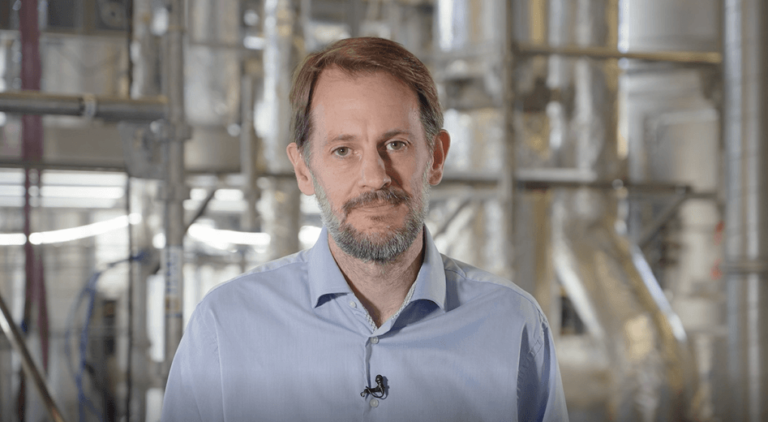News, events and interviews
Who is Scarlett?
This is our main development rig here in Stockholm – it´s what we call Scarlett. And it is our first development rig where we integrate all the elements of technology we need into one system. Previously we´ve tested gasification by itself, combustion by itself, but now we put them together and we see how they work in one system. So, it´s a great rig for us to learn how the technology works and to develop the prototypes we will later operate at full scale.
What kind of biomass do you use within Bio-Flex Gen?
We use different types of biomass, and they are, what we call, residues. We target things that other people can´t use, so called wastestreams. The kinds of biomass we will get, for example, from the forestry industry – that can´t be made into timber or into paper.

Michael Bartlett, Chief Technical Officer
How does a Biomass-fired Top Cycle (BTC) power plant work?
Combining two technologies for biopower
The main thing the BTC does, is it integrates two main technologies – one is a gas turbine and the other is a gasifier.
The way they are integrated is the way we make the efficiency so high and generate so much electricity: The gas turbine generates a lot of compressed air and that is taken to a gasifier. In the gasifier, we introduce a lot of biomass where it gets heated up quickly and releases all the gases which, are, in essence a fuel.
So it´s, mainly methane, carbonmonoxide and green hydrogen.
They come out at very high temperatures at 900 °Celsius in gasified form.
They have – among others – lots of ash components in them. And we want them to be solid so that we can remove the ash before they go to the gas turbine. So, we inject water and steam that cools the gases down to about 400 °Celsius.
Then, we can pass them through to the hot gas filter where we remove all those particles of the fly ash. Once we are through this system, we have a nice, clean fuel, which is a combination of hydrogen, methane, all these things from the gasification plus steam. And now, we are ready for combustion.
The combusted hot gas drives our gas turbine at 1400 °Celsius which gives it enormous power. And the gas turbine drives the generator which produces power which we use in our grids for electricity.
Extremely-high efficiency
Conventional combined heat and power plants are steam cycles. That means, you drive a turbine with hot steam at 500 °Celsius. We change this by driving a gas turbine at 1400 °Celsius, which is of course a much higher temperature giving more energy to the turbine and more power output. To make this even more efficient, we gather all the waste heat from the plant and recycle it to the gas turbine. This gives us a unique way of doubling the output from biomass to electricity.
Water recovery for circular economy
Once we´re finished with generating steam we have a flue gas which contains 50 percent water. And of course, you don´t want to waste that water. You condense that water in a flue gas condenser and that generates a lot of heat which we can use for heating houses in district heating networks. And that recovers all the water we need for the process so that we don´t impact the environment.
Where does the idea of a BTC plant come from?
Our unique highly efficient Biomass-fired Top Cycle (BTC) plant has its origins in the 1990s. And it was actually here at KTH campus in Stockholm where we sat down, a few of us, working on gas turbines with water and steam injection. And what we saw, if we go up in pressure, we get better and better results from the gas turbine. And then we realised something quite unexpectedly: When we started working with different feedstocks like biomass, we saw that we could bring all the waste heat from the biomass gasification into the same gas turbine system and thereby, get even better results.
How does Bio-FlexGen accelerate energy transition?
In Bio-FlexGen, we have the possibility to produce either electricity or hydrogen. And that is a unique feature that we have built into the system. So, once we have cleaned up the gases from the gasifier, we can either send it to combustion or to a hydrogen production unit. This this gives a unique flexibility in the market, where, depending on the prices, depending on market situations, we can produce electricity or hydrogen for our society. On a global level, the majority of our electricity and the majority of our hydrogen is produced from fossil fuels. This is, of course, not sustainable and results in climate change. Our Bio-FlexGen project aims to produce hydrogen or electricity from biomass which is sustainably sourced from waste streams. This means, the system is circular and produces renewable electricity and renewable hydrogen-boosting energy transition.
What are your main challenges?
A key challenge for our development is the public acceptance of biomass and hydrogen. Both are essential for our energy transition, and we are working very hard to ensure that we are part of a circular utilisation of biomass and that we are using hydrogen in the safest possible way.
What is the best part of Bio-FlexGen – on a personal level?
We are bringing together amazing, competent people to create something new, and so, e.g. Scarlett was built and has been commissioned by all sorts of people of all around the world. And for me, that is a crucial part of our development.
What is your mantra?
Developing any technology is difficult. What keeps me going is the fact that we can make a real difference, is the fact that we can make the energy transition faster and my kids will therefore have a better future.